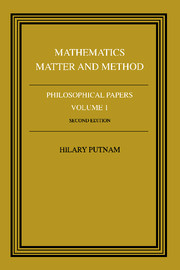Book contents
- Frontmatter
- Contents
- Dedication
- Introduction
- 1 Truth and necessity in mathematics
- 2 The thesis that mathematics is logic
- 3 Mathematics without foundations
- 4 What is mathematical truth?
- 5 Philosophy of physics
- 6 An examination of Grünbaum's philosophy of geometry
- 7 A philosopher looks at quantum mechanics
- 8 Discussion: comments on comments on comments: a reply to Margenau and Wigner
- 9 Three-valued logic
- 10 The logic of quantum mechanics
- 11 Time and physical geometry
- 12 Memo on ‘conventionalism’
- 13 What theories are not
- 14 Craig's theorem
- 15 It ain't necessarily so
- 16 The ‘corroboration’ of theories
- 17 ‘Degree of confirmation’ and inductive logic
- 18 Probability and confirmation
- 19 On properties
- 20 Philosophy of Logic
- Bibliography
- Index
6 - An examination of Grünbaum's philosophy of geometry
Published online by Cambridge University Press: 04 August 2010
- Frontmatter
- Contents
- Dedication
- Introduction
- 1 Truth and necessity in mathematics
- 2 The thesis that mathematics is logic
- 3 Mathematics without foundations
- 4 What is mathematical truth?
- 5 Philosophy of physics
- 6 An examination of Grünbaum's philosophy of geometry
- 7 A philosopher looks at quantum mechanics
- 8 Discussion: comments on comments on comments: a reply to Margenau and Wigner
- 9 Three-valued logic
- 10 The logic of quantum mechanics
- 11 Time and physical geometry
- 12 Memo on ‘conventionalism’
- 13 What theories are not
- 14 Craig's theorem
- 15 It ain't necessarily so
- 16 The ‘corroboration’ of theories
- 17 ‘Degree of confirmation’ and inductive logic
- 18 Probability and confirmation
- 19 On properties
- 20 Philosophy of Logic
- Bibliography
- Index
Summary
There is no doubt that the examination into the structure of physical geometry and relativity theory initiated by Reichenbach and continued by Grünbaum has extended our understanding and called our attention to matters of philosophical importance. Unfortunately, I find myself unable to agree with Grünbaum on a number of central points. I do agree that the ordinary standard of congruence in physical geometry is the solid rod. I do not agree that one can define ‘congruent’ in terms of solid rods in such a way as to make possible an empirical determination of the metric, especially if the need for correcting for perturbational or differential forces in accordance with some not exactly known system of physical laws is to be taken into account. The prevalent assumption to the contrary is due to an error committed by Reichenbach and frequently found in the literature of the past thirty years (the error of supposing that there must be ‘universal forces’ in any non-standard metric). What appears rather to be the case is that the metric is implicitly specified by the whole system of physical and geometrical laws and ‘correspondence rules’. § No very small subset by itself fully determines the metric; and certainly nothing that one could call a ‘definition’ does this.
Secondly, I believe that it is misleading to say, as Grünbaum does, that physical geometry provides ‘the articulation of the system of relations obtaining between bodies and transported solid rods quite apart from their substance-specific distortions’ (p. 510). What Grünbaum means is not really ‘quite apart from their substance-specific distortions’, but after proper correction has been made for their substance-specific distortions.
Information
- Type
- Chapter
- Information
- Mathematics, Matter and MethodPhilosophical Papers, pp. 93 - 129Publisher: Cambridge University PressPrint publication year: 1979
Accessibility standard: Unknown
Why this information is here
This section outlines the accessibility features of this content - including support for screen readers, full keyboard navigation and high-contrast display options. This may not be relevant for you.Accessibility Information
- 1
- Cited by
